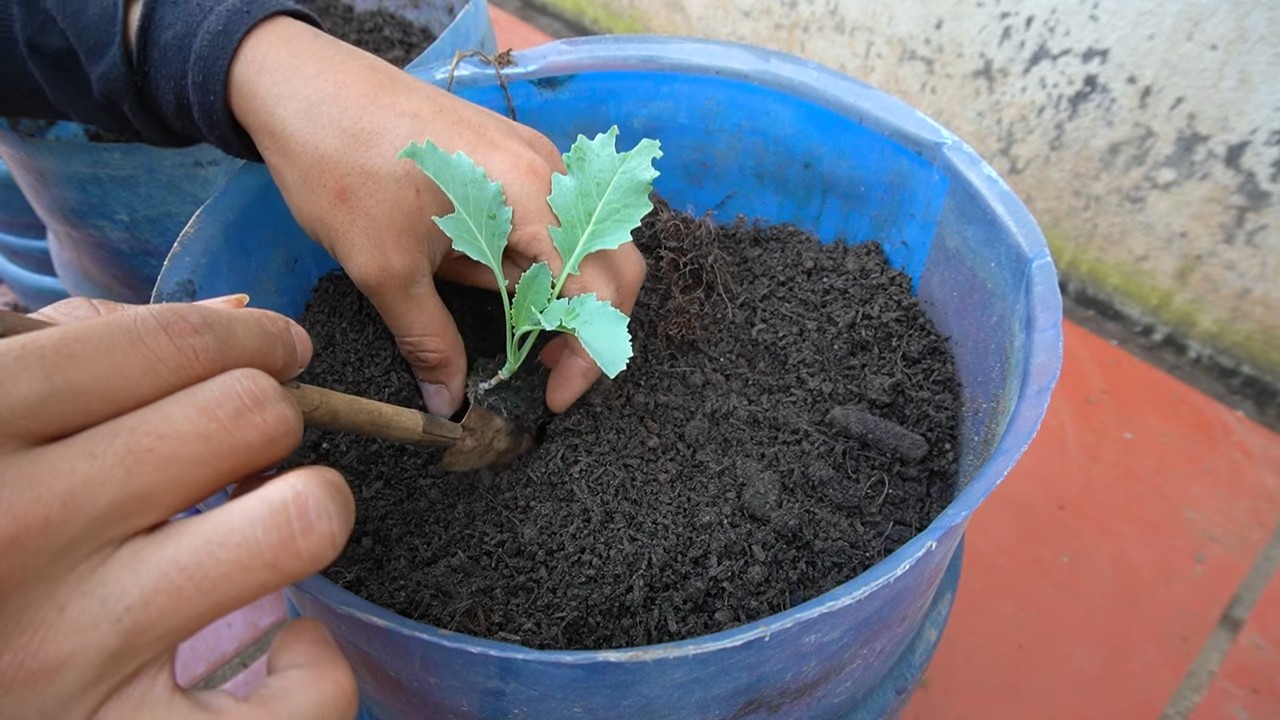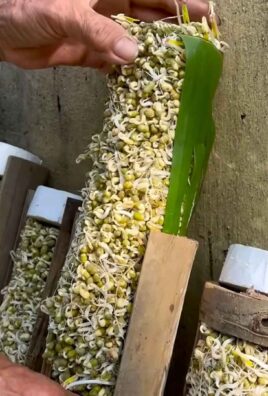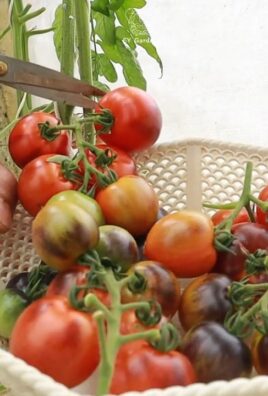Grow Garlic in Plastic Bags: Unlock a surprisingly simple secret to bountiful harvests, even without a traditional garden! Have you ever dreamt of enjoying the pungent, fresh flavor of homegrown garlic in your culinary creations? What if I told you that you could achieve this, not in a sprawling garden bed, but in something as simple as a plastic bag?
For centuries, garlic has been revered across cultures, from ancient Egypt where it fueled the pyramid builders, to traditional medicine where it was prized for its health benefits. Today, the joy of growing your own food, connecting with nature, and savoring the fruits (or in this case, bulbs!) of your labor is more appealing than ever. But let’s face it, not everyone has the space, time, or resources for a full-fledged garden.
That’s where this ingenious DIY trick comes in! Grow Garlic in Plastic Bags is a game-changer for apartment dwellers, balcony gardeners, or anyone looking for a low-cost, space-saving solution. Imagine the satisfaction of harvesting plump, flavorful garlic cloves from a humble plastic bag, ready to elevate your favorite dishes. This guide will walk you through each step, ensuring you have all the knowledge you need to succeed. Get ready to ditch the store-bought stuff and embrace the deliciousness of homegrown garlic, one plastic bag at a time!

Knoblauch Anbauen in Plastiktüten: Eine DIY-Anleitung für den Hobbygärtner
Hallo liebe Gartenfreunde! Habt ihr Lust, euren eigenen Knoblauch anzubauen, auch wenn ihr keinen Garten habt? Oder vielleicht wollt ihr einfach nur eine unkonventionelle Methode ausprobieren? Dann seid ihr hier genau richtig! Ich zeige euch, wie ihr Knoblauch ganz einfach in Plastiktüten ziehen könnt. Es ist überraschend einfach, platzsparend und macht richtig Spaß!
Was ihr braucht:
* Knoblauchzehen: Am besten Bio-Knoblauch aus dem Supermarkt oder vom Bauernmarkt. Achtet darauf, dass die Zehen fest und gesund aussehen.
* Plastiktüten: Stabile Plastiktüten, idealerweise solche, die man wiederverschließen kann (Zip-Beutel). Größe hängt davon ab, wie viele Zehen ihr pro Tüte pflanzen wollt. Ich empfehle Tüten mit einem Volumen von mindestens 3 Litern.
* Erde: Hochwertige Blumenerde oder Gemüseerde. Vermeidet Gartenerde, da diese oft zu schwer ist und Schädlinge enthalten kann.
* Wasser: Zum Befeuchten der Erde.
* Sprühflasche: Zum Besprühen der Blätter (optional).
* Etiketten und Stift: Zum Beschriften der Tüten (optional, aber empfehlenswert).
* Schere oder Messer: Zum Anritzen der Tüten für die Drainage.
* Geduld: Knoblauch braucht Zeit zum Wachsen!
Vorbereitung ist alles:
Bevor wir loslegen, sollten wir ein paar Vorbereitungen treffen, damit alles reibungslos abläuft.
1. Knoblauchzehen auswählen: Sucht euch die größten und gesündesten Knoblauchzehen aus. Je größer die Zehe, desto größer wird die Knoblauchknolle später.
2. Plastiktüten vorbereiten: Macht mit einer Schere oder einem Messer ein paar kleine Löcher in den Boden der Plastiktüten. Diese Löcher dienen als Drainage, damit das Wasser ablaufen kann und die Knoblauchzehen nicht faulen. Achtet darauf, dass die Löcher nicht zu groß sind, sonst rieselt die Erde heraus.
3. Erde vorbereiten: Lockert die Erde in einem Eimer oder einer Schüssel auf und befeuchtet sie leicht. Sie sollte feucht, aber nicht nass sein.
Schritt-für-Schritt-Anleitung: Knoblauch in Plastiktüten pflanzen
Jetzt geht es ans Eingemachte! Folgt diesen Schritten, und schon bald könnt ihr euren eigenen Knoblauch ernten.
1. Tüten befüllen: Füllt die Plastiktüten zu etwa zwei Dritteln mit der vorbereiteten Erde. Drückt die Erde leicht an.
2. Knoblauchzehen pflanzen: Steckt die Knoblauchzehen mit der Spitze nach oben in die Erde. Achtet darauf, dass die Zehen etwa 5-7 cm tief in der Erde stecken und genügend Abstand zueinander haben (ca. 5-7 cm). Je nach Größe der Tüte könnt ihr mehrere Zehen pro Tüte pflanzen.
3. Mit Erde bedecken: Bedeckt die Knoblauchzehen mit der restlichen Erde. Drückt die Erde leicht an.
4. Gießen: Gießt die Erde vorsichtig an, bis sie gut durchfeuchtet ist. Achtet darauf, dass kein Wasser in den Tüten steht.
5. Beschriften: Beschriftet die Tüten mit dem Datum und der Knoblauchsorte (falls bekannt). So behaltet ihr den Überblick.
6. Standort wählen: Stellt die Plastiktüten an einen hellen und kühlen Ort. Knoblauch braucht viel Licht, aber keine direkte Sonneneinstrahlung. Ein Platz auf dem Balkon, der Terrasse oder am Fensterbrett ist ideal.
7. Pflege: Gießt die Erde regelmäßig, aber nicht zu viel. Die Erde sollte immer leicht feucht sein. Vermeidet Staunässe. Besprüht die Blätter regelmäßig mit Wasser, um sie vor dem Austrocknen zu schützen.
8. Überwintern: Knoblauch ist winterhart. Wenn ihr ihn im Herbst gepflanzt habt, könnt ihr die Tüten draußen stehen lassen. Achtet aber darauf, dass die Erde nicht gefriert. Bei sehr kalten Temperaturen könnt ihr die Tüten mit Vlies abdecken.
9. Ernten: Knoblauch ist erntereif, wenn die Blätter gelb werden und absterben. Das ist in der Regel im Sommer der Fall. Zieht die Knoblauchknollen vorsichtig aus der Erde.
10. Trocknen: Lasst die Knoblauchknollen an einem trockenen und luftigen Ort trocknen. So halten sie sich länger.
Zusätzliche Tipps und Tricks:
* Sortenwahl: Es gibt verschiedene Knoblauchsorten. Einige sind besser für den Anbau in Töpfen geeignet als andere. Informiert euch vor dem Kauf über die verschiedenen Sorten.
* Düngen: Knoblauch braucht nicht viel Dünger. Eine leichte Düngung mit organischem Dünger im Frühjahr kann jedoch das Wachstum fördern.
* Schädlinge: Knoblauch ist relativ resistent gegen Schädlinge. Gelegentlich können Blattläuse auftreten. Diese könnt ihr mit einem Wasserstrahl oder mit einem biologischen Schädlingsbekämpfungsmittel bekämpfen.
* Krankheiten: Auch Krankheiten sind selten. Bei zu feuchter Erde kann es jedoch zu Pilzbefall kommen. Achtet daher auf eine gute Drainage.
* Erde wiederverwenden: Die Erde aus den Plastiktüten könnt ihr im nächsten Jahr wiederverwenden. Mischt sie einfach mit frischer Erde und etwas Kompost.
* Knoblauchblüten: Wenn der Knoblauch blüht, könnt ihr die Blütenstände abschneiden. So steckt die Pflanze mehr Energie in die Knollenbildung. Die Blütenstände sind übrigens auch essbar und schmecken lecker in Salaten oder als Pesto.
Häufige Probleme und Lösungen:
* Gelbe Blätter: Gelbe Blätter können verschiedene Ursachen haben. Entweder ist die Erde zu trocken, zu nass oder es fehlt Nährstoff. Überprüft die Bodenfeuchtigkeit und düngt gegebenenfalls.
* Kleine Knollen: Kleine Knollen können durch zu wenig Licht, zu wenig Wasser oder zu wenig Nährstoffe verursacht werden. Stellt die Tüten an einen helleren Ort, gießt regelmäßig und düngt gegebenenfalls.
* Faule Zehen: Faule Zehen sind meistens ein Zeichen von Staunässe. Achtet auf eine gute Drainage und gießt nicht zu viel.
Warum Knoblauch in Plastiktüten anbauen?
* Platzsparend: Ideal für Balkone, Terrassen und kleine Gärten.
* Flexibel: Die Tüten können leicht umgestellt werden, um den optimalen Standort zu finden.
* Einfach: Auch für Anfänger geeignet.
* Kostengünstig: Benötigt nur wenige Materialien.
* Nachhaltig: Wiederverwendung von Plastiktüten.
* Frischer Knoblauch: Immer frischer Knoblauch zur Hand.
Fazit:
Knoblauch in Plastiktüten anzubauen ist eine tolle Möglichkeit, auch ohne Garten frischen Knoblauch zu ernten. Es ist einfach, platzsparend und macht Spaß. Probiert es einfach aus! Ich bin sicher, ihr werdet begeistert sein. Viel Erfolg beim Gärtnern!

Conclusion
So, there you have it! Growing garlic in plastic bags is not just a quirky gardening experiment; it’s a game-changer for urban gardeners, space-conscious enthusiasts, and anyone looking for a simple, effective way to cultivate fresh, flavorful garlic. We’ve walked you through the process, highlighting the ease, convenience, and surprisingly impressive results you can achieve.
Why is this DIY trick a must-try? Because it democratizes garlic cultivation. You don’t need acres of land or a sprawling garden to enjoy the satisfaction of harvesting your own pungent bulbs. A sunny windowsill, a balcony, or even a well-lit corner of your apartment can become your personal garlic farm. The plastic bag method is incredibly forgiving, making it perfect for beginners who might be intimidated by traditional gardening techniques. It also minimizes weeding and soil-borne pests, leading to healthier, more robust garlic plants.
But the benefits don’t stop there. Growing your own garlic allows you to control the entire process, from the type of garlic you plant to the soil you use. You can choose organic options, ensuring that your garlic is free from harmful chemicals and pesticides. Plus, the flavor of homegrown garlic is simply unmatched. It’s more intense, more complex, and adds a depth of flavor to your dishes that store-bought garlic simply can’t replicate.
Looking to experiment? Consider these variations:
* Garlic Varieties: Don’t limit yourself to just one type of garlic. Try different varieties like softneck, hardneck, or elephant garlic to discover your personal favorite. Each variety has its own unique flavor profile and growth characteristics.
* Companion Planting: While the plastic bag method isolates the garlic, you can still incorporate companion planting principles. Place your garlic bags near other plants that benefit from its presence, such as tomatoes or roses, to deter pests.
* Vertical Gardening: If space is truly limited, consider creating a vertical garlic garden by hanging your plastic bags from a sturdy structure. This not only saves space but also adds a visually appealing element to your growing area.
* Successive Planting: To ensure a continuous supply of fresh garlic, stagger your planting times. Plant a new batch of garlic every few weeks to have a steady harvest throughout the growing season.
We are confident that once you experience the joy of harvesting your own homegrown garlic, you’ll be hooked. The process is simple, the results are rewarding, and the flavor is simply irresistible. So, grab some plastic bags, some good quality soil, and your favorite garlic cloves, and get ready to embark on a flavorful gardening adventure.
We encourage you to try this DIY trick and share your experience with us! Post photos of your garlic bags, tell us about your favorite garlic varieties, and let us know what culinary creations you’ve made with your homegrown harvest. Your feedback will not only inspire others but also help us refine and improve this method for future garlic growers. Let’s cultivate a community of garlic lovers, one plastic bag at a time! Remember, the key to successful gardening, even in a plastic bag, is patience, observation, and a willingness to learn. Happy growing!
Frequently Asked Questions (FAQ)
Q: What kind of plastic bags should I use?
A: Ideally, you should use sturdy, reusable plastic bags that are at least a gallon in size. Grocery bags work well, but thicker, more durable bags are preferable as they are less likely to tear. Make sure the bags are clean and free of any holes or tears before planting. You can also use grow bags made of fabric, which offer better drainage and aeration.
Q: What kind of soil should I use for growing garlic in plastic bags?
A: Use a well-draining potting mix that is rich in organic matter. Avoid using garden soil, as it can be too heavy and may not drain properly in a plastic bag. You can also amend your potting mix with compost or aged manure to provide additional nutrients for your garlic plants. A good mix would be equal parts potting soil, compost, and perlite or vermiculite for drainage.
Q: How often should I water my garlic plants in plastic bags?
A: Water your garlic plants regularly, keeping the soil consistently moist but not waterlogged. Check the soil moisture by sticking your finger into the soil. If the top inch feels dry, it’s time to water. Avoid overwatering, as this can lead to root rot. The frequency of watering will depend on the weather conditions and the type of plastic bag you are using. Bags with drainage holes will require more frequent watering than those without.
Q: How much sunlight do garlic plants need when grown in plastic bags?
A: Garlic plants need at least 6-8 hours of direct sunlight per day to thrive. Place your plastic bags in a sunny location, such as a south-facing window or a balcony that receives plenty of sunlight. If you don’t have enough natural sunlight, you can supplement with grow lights.
Q: When is the best time to plant garlic in plastic bags?
A: The best time to plant garlic is in the fall, about 4-6 weeks before the first frost. This allows the garlic cloves to establish roots before winter. In warmer climates, you can plant garlic in late winter or early spring.
Q: How long does it take to grow garlic in plastic bags?
A: Garlic typically takes about 8-9 months to mature. You’ll know it’s ready to harvest when the leaves start to turn yellow and brown.
Q: How do I harvest garlic grown in plastic bags?
A: When the leaves start to turn yellow and brown, stop watering your garlic plants. Gently loosen the soil around the base of the plant and carefully pull the garlic bulb out of the bag. Cure the garlic by hanging it in a cool, dry, and well-ventilated place for 2-3 weeks.
Q: Can I reuse the soil in the plastic bags after harvesting the garlic?
A: It’s generally not recommended to reuse the soil in the plastic bags after harvesting garlic, as it may contain pests or diseases. However, if you choose to reuse the soil, you should amend it with fresh compost and fertilizer to replenish the nutrients.
Q: What are some common problems when growing garlic in plastic bags?
A: Some common problems include root rot (due to overwatering), pests (such as aphids or thrips), and diseases (such as white rot or garlic rust). To prevent these problems, use well-draining soil, water carefully, and inspect your plants regularly for signs of pests or diseases.
Q: Can I grow other vegetables in plastic bags using the same method?
A: Yes, you can grow other vegetables in plastic bags using a similar method. Some good options include tomatoes, peppers, lettuce, and herbs. Just be sure to choose the right size bag and soil mix for the specific vegetable you are growing.




Leave a Comment